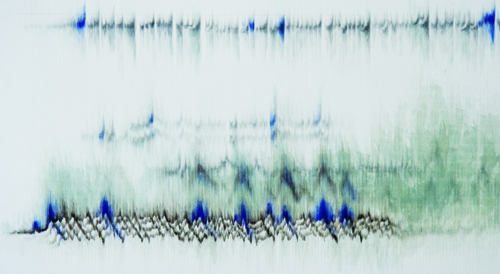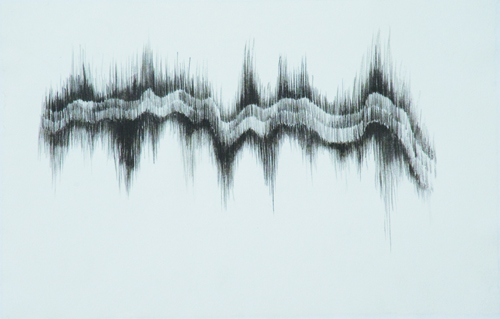It was a dark and stormy night as Meredith Birrell forsook comfort for art…
It was a cold winter’s night and fantasies of snuggling up with blankets and hot chocolate filled my head. But I braved the conditions in the name of art, buttoned up and pressed on. Well worth it, too, for Cindy Chen’s show, Drawing Breath at Kudos Gallery in Paddington, which proved to be a real pleasure.
These are pictures that reward viewing in the flesh as only then can you see the skill in their making and the subtle shifts in colour, tone and rhythm that makes these works so beautiful. Chen has responded to Buddhist chanting with her own system of mark-making. She has worked within seemingly quite limited parameters, but her response is still intuitive, bringing in an element of the arbitrary while still maintaining a sophisticated logic throughout the work.
Cindy Chen, Eight Fold: Dhammacakkapavattana Sutta, 2011.
Dimensions variable*, Chinese/Japanese traditional ink, shellac based ink, colour pencil, watercolour on Wen Zhou paper. Image courtesy of the artist.
These drawings, made with traditional and modern inks, coloured pencil and watercolour on paper, are about rhythm and they invite a consideration of them as soundscapes as much as visual entities. Although specific in their source of meaning, this sort of traveling image that you move along, up and down and into and out of has an inviting generality that is very seductive. They are not images of things and they defy any normal notions of pictorial compositions, but that is their point. It is only circumstantial that the works end at the edge of the paper, because they really go on infinitely and having impressed upon you their rhythmic power, they stay within you indefinitely also, as does a piece of music. In drawing breath, you take in life. Historically the word ‘inspire’ meant both breathing in and taking in divine knowledge, it had both a physical and a metaphysical sense. I think here this notion also asks us to pause, take a breath and be present, to contemplate.
There is both great strength and softness in these drawings, a confidence and uncertainty. The structure of the drawing is often quite dense, Chen has used black in most of them, but these intense areas are counteracted with fine-as-hair marks and incredibly delicate clouds of colour. It is only by close scrutiny at times that you can discern white paper from a wash of tone. The Wen Zhou paper Chen has used, made from mulberry pulp, has a fine soft grain that adds another textural dimension only discernible at close-range. In reproduction, they might look as if they were machine-generated, but it is in the discovery and marveling of them as hand-made things that adds to their appeal.
Cindy Chen, Preliminary Study – Vox Humana, 2011.
Chinese/Japanese traditional ink, shellac based ink, colour pencil, watercolour on Wen Zhou paper. 24.5cm x 38.5cm. Image courtesy of the artist
Chen has created great atmosphere within these modest works and they achieve that difficult balance between being very much about surface and suggesting great depth. This depth though is both intellectual and perceptual. In thinking of the chanting that inspired these drawings, the depth within the music, its tones and shifts are felt, but in looking at the works, one also starts to see mountains, forests and misty panoramas, conjuring up an imagined landscape. This duality is most clearly at the fore in Chen’s screen work, Soundscape: Dhammacakkappavattana sutta. Using the traditional form of the paper screen, a domestic object that typically depicted landscapes, Chen is making a link between the rhythms of music and the land and bringing together our sense of hearing, vision and touch.
These are works that well deserve contemplation. They really are as much about being in the mind as being physically present. In looking out, we perceive something that is inner and inscrutable. Well worth braving the winter wind and rain.
Drawing Breath, Cindy Chen
Kudos Gallery, until 18th June


